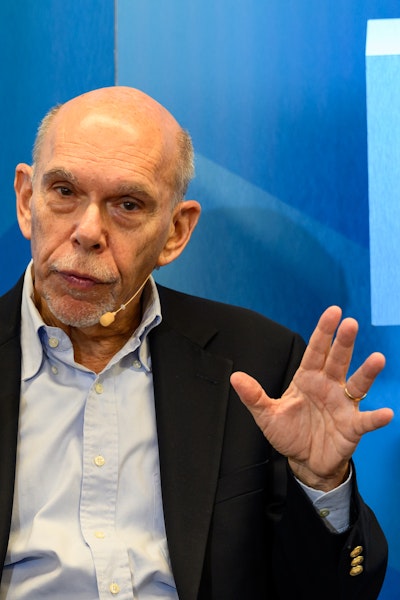
The God Particle
Setup
Physicist Brian Greene explains the Higgs boson particle, also known as the "God Particle," and why you should care about it. This energetic and delightful talk will make you wish your high school physics teacher taught like this. Greene says the feat of finding such a particle is akin to "trying to hear a tiny, delicate whisper over the massive thundering, deafening din of a NASCAR race."
Greene gave this talk in 2012 just days before CERN (the European Organization for Nuclear Research) confirmed the theory of the Higgs boson using the Large Hadron Collider. The following year, the Nobel prize in physics was awarded jointly to François Englert and Peter Higgs “for the theoretical discovery of a mechanism that contributes to our understanding of the origin of mass of subatomic particles.”
- 2012 Festival
- Science
- Full transcript
Space is sticky like molasses
Around 1970, Peter Higgs imagines that all of space is uniformly filled with an invisible substance that’s sort of like molasses. When a particle, like an electron, tries to move through this molasses, the resistance it encounters is what we interpret as the mass of the particle. In fact, the idea is that different particles would have different degrees of stickiness which means they would experience a different amount of resistance as they try to borrow through this pervasive molasses. Higgs’s theory, if proven, would rewrite the very meaning of nothingness because the field, or molasses, is essentially an unremoveable occupant of space.
How are scientists looking for this invisible, molasses-like field?
The Large Hadron Collider at CERN, in Geneva, is about 18 miles around. Protons are sent cycling around the collider in opposite directions, near the speed of light, so fast that they can traverse that 18-mile race track more than 11,000 times each second. And these particles engage in head-on collisions. It’s a monumental challenge to carry out this procedure. “It’s like trying to hear a tiny, delicate whisper over the thundering, deafening din of a NASCAR race,” says Greene.
By the numbers
What’s the point of finding and confirming the Higgs particle?
Fundamental discovery can have a profound impact on the way we live our lives, but we must wait for theoretical discoveries to turn into practical applications. Confirming the existence of the Higgs particle in 2012 substantiated 30 years of theoretical science. In short, the Higgs discovery put the bang in the Big Bang Theory.
Why it matters
Why should we care about something so specific to theoretical physics?
Greene goes on to give his personal reasons for pursuing science and discovery:
Learn More
Additional Information
Explore More
Science

Space… the final metaphor for the unknowable. But we are certainly trying to understand what goes on out there, and the more we learn, the more fascinating questions start to...

Since 2014, Aspen Ideas: Health has welcomed nearly 800 inspiring women leaders to our stages to share their bold approaches to better health. In honor of Women's History Mont...

Setting audacious goals helps to redefine what is achievable in health, medicine, and science. As we deepen understanding of the human genome, unravel the mysteries of the bra...


Research on aging and extending life and healthspan has ventured beyond humans to our best animal friends – dogs. In less than a year, dog owners may be able to buy a drug tha...

The recognition that all things are connected is at once a scientific principle and a philosophical touchstone. Humans, animals, and the environment are intertwined in complex...

For as long as humans have looked at the skies, we’ve speculated about whether there is life in space. Scientists, the U.S. military and the CIA have all searched for proof of...

It sounds like sci-fi: Scientists are beaming solar energy from space, subbing seaweed for plastic and brightening clouds to reflect sunlight to lower temperatures in a warmin...

*No food or service animals allowed in this session.* The creator of Fat Bear Week in Alaska gives insight on the importance of wildlife education, and then ecologists unpack...

Brain-computer interfaces show potential to restore function to people impacted by incurable neurological conditions such as stroke, spinal cord injury, traumatic brain injury...

Scientists are developing life-extending drugs for dogs, and new advancements could bring them to market by 2025. Two leaders working to slow the aging process for Fido discus...

Few people are more deeply steeped in science than Francis Collins, former director of the National Institutes of Health and the groundbreaking Human Genome Project, and forme...

Part 1. Contrary to Popular Opinion — Bill Maher in Real Time: The iconoclastic host of HBO’s “Real Time with Bill Maher” sits down with Tina Brown to talk about calling out...

The idea of gathering DNA samples into a vast database in order to identify disease risks and breakthrough therapies was once a distant dream. Not long ago, immunotherapy seem...

From in vitro fertilization (IVF), which combines human eggs and sperm outside the body, to in vitro gametogenesis (IVG), which uses stem cells to create gametes, pregnancy is...

The hormonal changes and hot flashes that accompany menopause are familiar to most women, but the accompanying brain changes have not received as much attention. We now know t...

The communities we call home and the ways we live greatly influence health and longevity. By studying “Blue Zones” around the globe, Dan Buettner has uncovered the macro-level...

The first drug in a class known as GLP-1 agonists was approved in 2005 to treat diabetes. GLP-1 drugs subsequently proved their mettle to treat obesity and prevent major cardi...

Scientific investigation is laser focused on psychedelics to treat post-traumatic stress disorder (PTSD), ease end-of-life anxiety, and address mental health challenges, inclu...

Artificial intelligence is generating enormous excitement for its potential to predict health risks, speed diagnoses, and guide medical decision making. At the same time, the...

The health benefits of a nutritious diet are well-established, but just telling people to eat more plant-based foods and less unhealthy fat isn’t enough to reduce the toll of...









